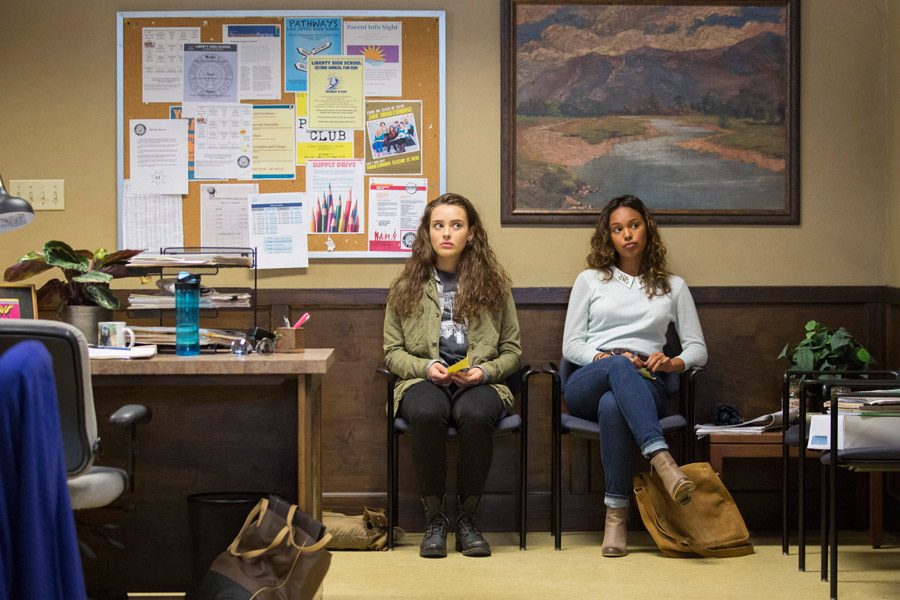More than 13 reasons to watch
Katherine Langford, left, and Alisha Boe play frenemies in the Netflix series “13 Reasons Why.” Photo by Beth Dubber/Netflix
April 20, 2017
The Butterfly Effect: a butterfly flaps its wings over the ocean and there’s a hurricane in Asia. It is the concept that all things are connected, and that small actions can have large effects. “13 Reasons Why” is a huge butterfly effect: thirteen different butterflies, one huge hurricane that destroys life as they know it.
I am very critical of the topic of suicide portrayed in media. I believe that unless you have been through the struggle, you can never do it justice. No matter how amazing the author is, suicide is a topic where characters, lyrics and sympathy just aren’t enough. I have always believed this. I was proved wrong.
“13 Reasons Why” follows the events of Clay Jensen’s life after he receives tapes left behind by fellow student Hannah Baker, clarifying her reasons for committing suicide. To his surprise, he’s one of the lucky thirteen reasons. Jensen doesn’t know who left the tapes at his door, only that he must listen to all of them and pass them on to the next person responsible for Baker’s death.
The aspect I loved most about this series was its bluntness. Nothing was censored. They didn’t cut scenes out or gloss over any topic. They called it like they saw it. High school wasn’t depicted as a place where everyone sat quietly in a classroom, supported each other or lived in picture perfect homes with white fences. When the bullying scenes were filmed, every reaction and verbal abuse was shown. The fight scene was shown start to finish, every punch and drop of blood caught. Even the suicide scene was shown in every bloody detail. Each scene made you feel the pain that Hannah felt. Each scene made it feel real.
One of the most thought-provoking aspects of “13 Reasons Why” was the fact that ordinary people were the causes of such a horrific event. They weren’t your cliche mean girls who terrorize everyone around them and make you bow down to their superiority. Yes, Hannah dealt with the typical dumb, immature jocks, but they were just a few of her bullies. Her ex-best friends, co-worker, class president, yearbook photographer and adults contributed to Hannah’s suicide. The popular kids, outsiders, counselors and parents all overlooked a girl calling out for help. This made me think about how it doesn’t take just mean people to cause someone pain or make them feel alone. It can be the people who love you that set the ball rolling on a path to self-destruction. It made you think about whether or not you pay enough attention and show enough love to the people you consider loved ones.
Something that made my veins boil was how these 13 causes of suicide never truly admitted that they were to blame for Hannah’s death. Besides Clay, Alex and Zach, no one felt sorry for what they did. Instead, all of them wanted to make sure the tapes were never released, which would have happened if one of them didn’t follow Hannah’s rules. It angered me that Hannah’s life was ruined by them, but it was okay. She just handled her life in a bad way. But when their lives were threatened, they would stop at nothing to make sure that the tapes remained confidential. These killers were worried about their scholarships, acceptance letters, social statuses and more, but didn’t stop to think about the fact that the caused someone to take her own life. They could blame each other and threaten the people who wanted to do the right thing, but they couldn’t admit that it was their own thoughts.
One thing the directors did a great job of was effectively using Hannah’s flashbacks to explain her interactions with each person on the tapes. These flashbacks took the watcher back to the events that led Hannah to her death as Clay listened to the tapes. The flashbacks were used as an insight into the mind of someone going into a dark place. They didn’t just talk about the effects of a suicide, but the mindset of someone leading up to and going through an actual suicide. The directors were also creatively efficient in their editing. During a flashback the lighting was brighter, which symbolized how Clay felt with Hannah in his life. During the present time, the lighting was darker because that was how he felt after her suicide. Every phrase, costume and camera focus was deliberate. There wasn’t one moment where I wondered why they added a certain scene or found a wasted second. Everything I watched purposefully contributed to the reason Hannah committed suicide.
“13 Reasons Why” has now made its way to my favorite Netflix show of all time. It was thought provoking, blunt and realer than any show I’ve seen. It was a cross between “Pretty Little Liars” and “Degrassi:” mystery meets teenage struggles. This would be a perfect binge for anyone debating whether or not they want to give it a try. Even if the topic of suicide isn’t pleasing to you, like it was for me, I would recommend you give it a try. It will open your eyes to the harsh reality of suicide and regret.















